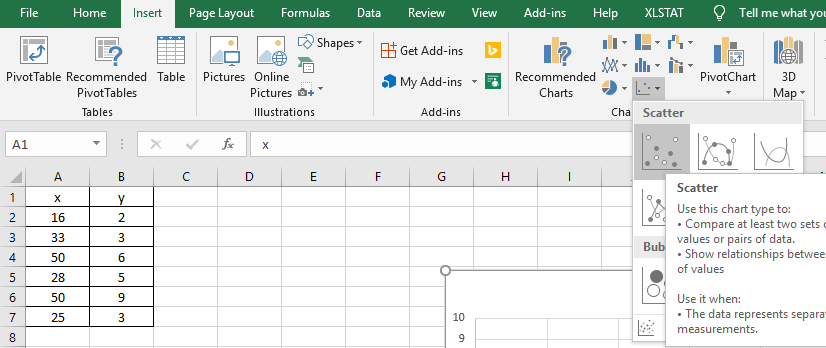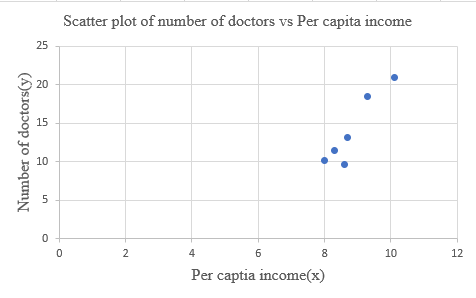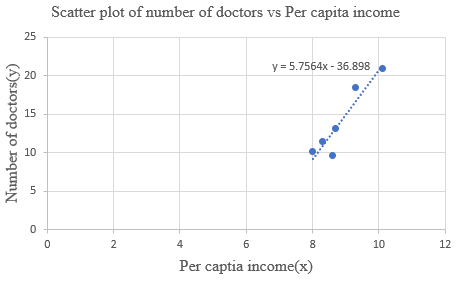
Concept explainers
Incoine: Medicai Care Let x be per capita income in thousands of dollars. Let y be the number of medical doctors per 10,000 residents. Six small cities in Oregon gave the following information about x and y(based on information from Lifein America's Small Cities by G. S. Thomas, Prometheus Books).
| x | 8.6 | 9.3 | 10.1 | 8.0 | 8.3 | 8.7 |
| y | 9.6 | 18.5 | 20.9 | 10.2 | 11.4 | 13.1 |
Complete parts (a) through (e), given
(a)
To graph: The scatter diagram.
Explanation of Solution
Given: The data that consists of the variables ‘per capita income in thousands of dollars’ and ‘the number of medical doctors per 10,000 residents’, which are represented by x and y, respectively, are provided.
Graph:
Follow the steps given below in MS Excel to obtain the scatter diagram of the data.
Step 1: Enter the data into an MS Excel sheet. The screenshot is given below.

Step 2: Select the data and click on ‘Insert’. Go to ‘charts’ and select ‘Scatter’ as the chart type.

Step 3: Select the first plot and click the ‘add chart element’ option provided in the left-hand corner of the menu bar. Insert the ‘Axis titles’ and the ‘Chart title’. The scatter plot for the provided data is shown below.

Interpretation: The scatterplot shows that the correlation between the per capita income (x) and the number of medical doctors (y) is positive. So, as x increases (or decreases), the value of y increases (or decreases).
(b)
To test: Whether the provided values of
Answer to Problem 13P
Solution: The provided values, that is,
Explanation of Solution
Given: The provided values are
Calculation:
To compute
| 8.6 | 9.6 | 73.96 | 92.16 | 82.56 |
| 9.3 | 18.5 | 86.49 | 342.25 | 172.05 |
| 10.1 | 20.9 | 102.01 | 436.81 | 211.09 |
| 8 | 10.2 | 64 | 104.04 | 81.6 |
| 8.3 | 11.4 | 68.89 | 129.96 | 94.62 |
| 8.7 | 13.1 | 75.69 | 171.61 | 113.97 |
Now, the value of
Substitute the values in the above formula. Thus:
Thus, the value of
Conclusion: The provided values, that is,
(c)
To find: The values of
Answer to Problem 13P
Solution: The calculated values are
Explanation of Solution
Given: The provided values are
Calculation:
The value of
The value of
The value of
The value of
Therefore, the values are
The general formula of a least-squares line is:
Here, a is the y-intercept and b is the slope.
Substitute the values of a and b in the general equation to get the equation of the least-squares line of the data as follows:
Therefore, the least-squares line equation is
(d)
To graph: The least-squares line on the scatter diagram that passes through the point
Explanation of Solution
Given: The data that consists of the variables ‘per capita income’ and ‘the number of medical doctors per 10,000 residents’, which are represented by x and y, respectively, are provided.
Graph:
Follow the steps given below in MS Excel to obtain the scatter diagram of the data.
Step 1: Enter the data into an MS Excel sheet. The screenshot is given below.

Step 2: Select the data and click on ‘Insert’. Go to ‘charts’ and select ‘Scatter’ as the chart type.

Step 3: Select the first plot and click the ‘add chart element’ option provided in the left-hand corner of the menu bar. Insert the ‘Axis titles’ and the ‘Chart title’. The scatter plot for the provided data is shown below.

Step 4: Right click on any data point and select ‘Add Trendline’. In the dialogue box, select ‘linear’ and check ‘Display Equation on Chart’. The scatter diagram with the least-squares line is given below.

Interpretation: The least-squares line passes through the point
(e)
The value of
Answer to Problem 13P
Solution: The value of
Explanation of Solution
Given: The value of the correlation coefficient (r) is
Calculation: The coefficient of determination
Therefore, the value of
Further, the proportion of variation in y that cannot be explained can be calculated as:
Hence, the percentage of variation in y that cannot be explained is 12.8%.
Interpretation: About 87.2% of the variation in y can be explained by the corresponding variation in x and the least-squares line while the remaining 12.8% of variation cannot be explained.
(f)
To find: The predicted number of MDs (medical doctors) per 10,000 residents.
Answer to Problem 13P
Solution: The predicted value is 20.7 physicians per 10,000 residents.
Explanation of Solution
Given: The least-squares line from part (c) is
Calculation:
The predicted value
Thus, the value of
Interpretation: The predicted number of medical doctors per 10,000 residents for a city with a per capita income of 10 thousand dollars is 20.7.
Want to see more full solutions like this?
Chapter 4 Solutions
UNDERSTANDING BASIC STATISTICS (LOOSE)
- The following ordered data list shows the data speeds for cell phones used by a telephone company at an airport: A. Calculate the Measures of Central Tendency from the ungrouped data list. B. Group the data in an appropriate frequency table. C. Calculate the Measures of Central Tendency using the table in point B. 0.8 1.4 1.8 1.9 3.2 3.6 4.5 4.5 4.6 6.2 6.5 7.7 7.9 9.9 10.2 10.3 10.9 11.1 11.1 11.6 11.8 12.0 13.1 13.5 13.7 14.1 14.2 14.7 15.0 15.1 15.5 15.8 16.0 17.5 18.2 20.2 21.1 21.5 22.2 22.4 23.1 24.5 25.7 28.5 34.6 38.5 43.0 55.6 71.3 77.8arrow_forwardII Consider the following data matrix X: X1 X2 0.5 0.4 0.2 0.5 0.5 0.5 10.3 10 10.1 10.4 10.1 10.5 What will the resulting clusters be when using the k-Means method with k = 2. In your own words, explain why this result is indeed expected, i.e. why this clustering minimises the ESS map.arrow_forwardwhy the answer is 3 and 10?arrow_forward
- PS 9 Two films are shown on screen A and screen B at a cinema each evening. The numbers of people viewing the films on 12 consecutive evenings are shown in the back-to-back stem-and-leaf diagram. Screen A (12) Screen B (12) 8 037 34 7 6 4 0 534 74 1645678 92 71689 Key: 116|4 represents 61 viewers for A and 64 viewers for B A second stem-and-leaf diagram (with rows of the same width as the previous diagram) is drawn showing the total number of people viewing films at the cinema on each of these 12 evenings. Find the least and greatest possible number of rows that this second diagram could have. TIP On the evening when 30 people viewed films on screen A, there could have been as few as 37 or as many as 79 people viewing films on screen B.arrow_forwardQ.2.4 There are twelve (12) teams participating in a pub quiz. What is the probability of correctly predicting the top three teams at the end of the competition, in the correct order? Give your final answer as a fraction in its simplest form.arrow_forwardThe table below indicates the number of years of experience of a sample of employees who work on a particular production line and the corresponding number of units of a good that each employee produced last month. Years of Experience (x) Number of Goods (y) 11 63 5 57 1 48 4 54 5 45 3 51 Q.1.1 By completing the table below and then applying the relevant formulae, determine the line of best fit for this bivariate data set. Do NOT change the units for the variables. X y X2 xy Ex= Ey= EX2 EXY= Q.1.2 Estimate the number of units of the good that would have been produced last month by an employee with 8 years of experience. Q.1.3 Using your calculator, determine the coefficient of correlation for the data set. Interpret your answer. Q.1.4 Compute the coefficient of determination for the data set. Interpret your answer.arrow_forward
- Can you answer this question for mearrow_forwardTechniques QUAT6221 2025 PT B... TM Tabudi Maphoru Activities Assessments Class Progress lIE Library • Help v The table below shows the prices (R) and quantities (kg) of rice, meat and potatoes items bought during 2013 and 2014: 2013 2014 P1Qo PoQo Q1Po P1Q1 Price Ро Quantity Qo Price P1 Quantity Q1 Rice 7 80 6 70 480 560 490 420 Meat 30 50 35 60 1 750 1 500 1 800 2 100 Potatoes 3 100 3 100 300 300 300 300 TOTAL 40 230 44 230 2 530 2 360 2 590 2 820 Instructions: 1 Corall dawn to tha bottom of thir ceraan urina se se tha haca nariad in archerca antarand cubmit Q Search ENG US 口X 2025/05arrow_forwardThe table below indicates the number of years of experience of a sample of employees who work on a particular production line and the corresponding number of units of a good that each employee produced last month. Years of Experience (x) Number of Goods (y) 11 63 5 57 1 48 4 54 45 3 51 Q.1.1 By completing the table below and then applying the relevant formulae, determine the line of best fit for this bivariate data set. Do NOT change the units for the variables. X y X2 xy Ex= Ey= EX2 EXY= Q.1.2 Estimate the number of units of the good that would have been produced last month by an employee with 8 years of experience. Q.1.3 Using your calculator, determine the coefficient of correlation for the data set. Interpret your answer. Q.1.4 Compute the coefficient of determination for the data set. Interpret your answer.arrow_forward
 Algebra: Structure And Method, Book 1AlgebraISBN:9780395977224Author:Richard G. Brown, Mary P. Dolciani, Robert H. Sorgenfrey, William L. ColePublisher:McDougal Littell
Algebra: Structure And Method, Book 1AlgebraISBN:9780395977224Author:Richard G. Brown, Mary P. Dolciani, Robert H. Sorgenfrey, William L. ColePublisher:McDougal Littell Glencoe Algebra 1, Student Edition, 9780079039897...AlgebraISBN:9780079039897Author:CarterPublisher:McGraw Hill
Glencoe Algebra 1, Student Edition, 9780079039897...AlgebraISBN:9780079039897Author:CarterPublisher:McGraw Hill Elementary Geometry For College Students, 7eGeometryISBN:9781337614085Author:Alexander, Daniel C.; Koeberlein, Geralyn M.Publisher:Cengage,
Elementary Geometry For College Students, 7eGeometryISBN:9781337614085Author:Alexander, Daniel C.; Koeberlein, Geralyn M.Publisher:Cengage, College Algebra (MindTap Course List)AlgebraISBN:9781305652231Author:R. David Gustafson, Jeff HughesPublisher:Cengage Learning
College Algebra (MindTap Course List)AlgebraISBN:9781305652231Author:R. David Gustafson, Jeff HughesPublisher:Cengage Learning College AlgebraAlgebraISBN:9781305115545Author:James Stewart, Lothar Redlin, Saleem WatsonPublisher:Cengage Learning
College AlgebraAlgebraISBN:9781305115545Author:James Stewart, Lothar Redlin, Saleem WatsonPublisher:Cengage Learning Mathematics For Machine TechnologyAdvanced MathISBN:9781337798310Author:Peterson, John.Publisher:Cengage Learning,
Mathematics For Machine TechnologyAdvanced MathISBN:9781337798310Author:Peterson, John.Publisher:Cengage Learning,





